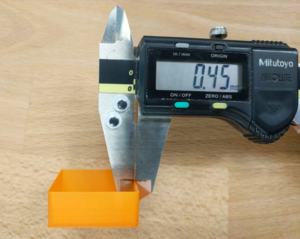FFF Printer Tuning for Accuracy
By accounting for a variety of factors that affect the accuracy of our printing process, we can dial in our 3D printers to get a fairly sufficient level of accuracy for functional, mechanical prototypes. Here's a breakdown of the factors to tune.
Contents
A Note About Overhangs
When using a printer that does not print dissolvable support material, I generally avoid designing features that require printing overhangs if the associated dimensions must be held to a fine degree of accuracy. Here's why.
Since printers can't print over thin air, we usually print support structures such that we can print any overhanging features in our part. When these parts finish printing, we remove the support material by ripping it away from the surface of the model, usually with pliers, or other tools. When this support material is made from the same filament type as the material of the part, it will fuse to the part. For this reason, slicer software packages will create a small air gap between the part material and the support material such that the printed part does not fully adhere to the support material. This air gap is called the interface layer. While it makes removing support material easier, it necessitates that this region will droop as it cools until it rests on the support material. Furthermore, the 3D printed region that rests on support material made from the same material as the part is usually jagged and aesthetically unpleasing.
Because the dimensions are difficult to know in advance because of this interface layer spacing, I generally avoid printing overhangs for important dimensions if I can help it.
Extrusion Width
Even though nozzles come in fixed sizes, the resulting extruded line is almost always slightly thicker after it has been deposited onto the forming part. This happens for a variety of reasons. But the main reason is that each subsequent layer is squished onto the prior layer with some overlap to ensure that the two layers fuse. Accounting for this thickness is key to getting accurate feature sizes, especially for small holes.
Measuring Extrusion Width
We can measure extrusion width from a flat surface of a single-layer thick wall. To create such a test object, simply print a cube with an open top in vase mode. From here, measure the wall with a pair of calipers.
Accounting for Extrusion Width
Most slicers actually have a setting for extrusion width. Simply input your measured value.
Perimeter Ordering
For tighter-tolerances, print the outermost perimeter first, followed by the inner perimeters. Doing so yields tighter toleranced features (esp: holes) than printing innnermost-to-outermost. The reason why has to do with what's happening to the filament as it is being deposited. When printing any adjacent perimeters, imagine that the first perimeter wall is cooler and more solid than the second perimeter wall. As the second perimeter is printed with some slight overlap with the first, it is effectively "rolling" off of the original perimeter. The original perimeter is cooler and more solid, so it doesn't move as a result of the new perimeter overlapping it. The current perimeter being deposited, however, is still melted and does shift slightly as it rolls off the prior perimeter.
The most-obvious symptom of printing innermost-to-outermost is that parts will seem to be slightly too small no matter what settings you tweak.
